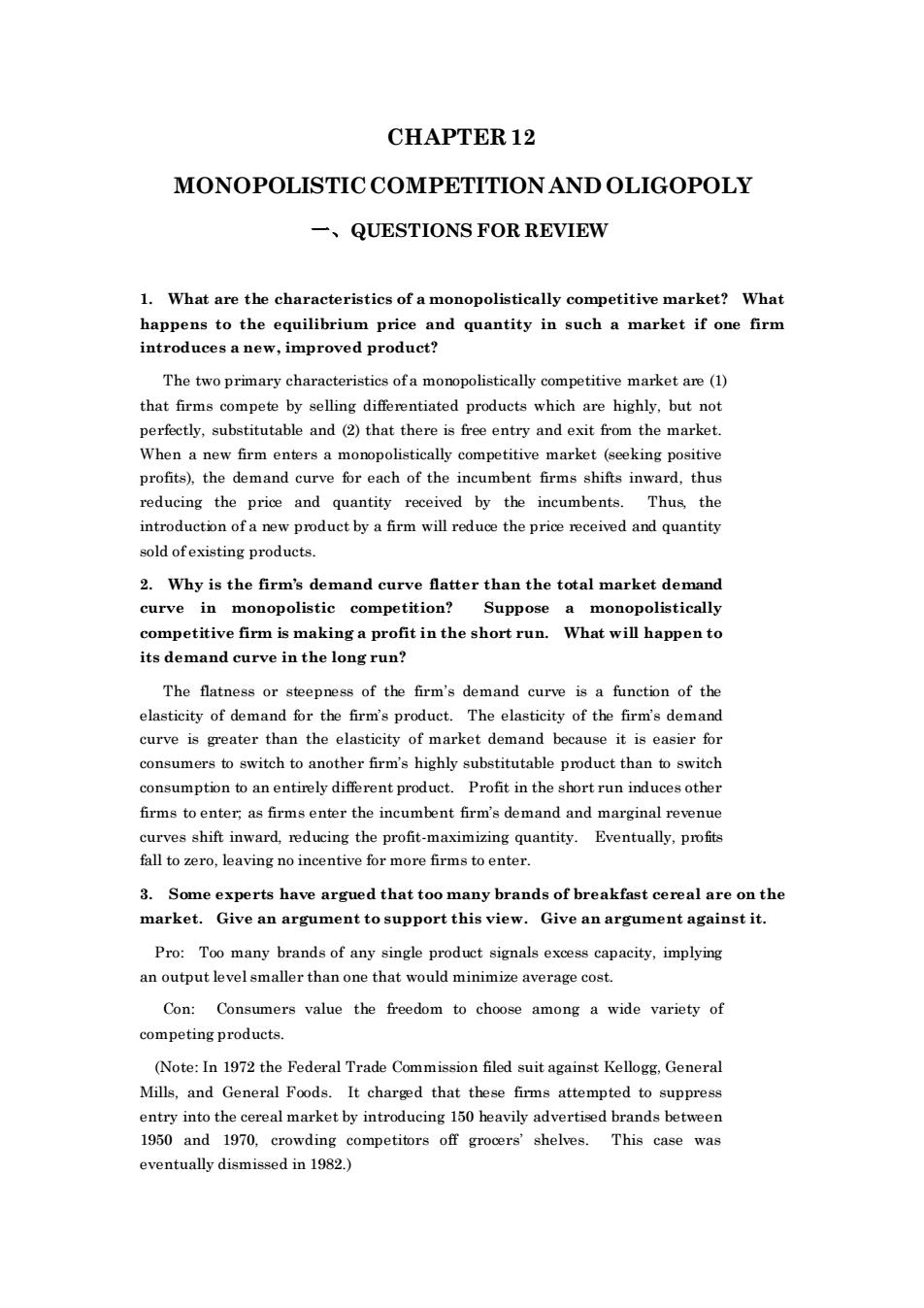
CHAPTER 12 MONOPOLISTIC COMPETITION AND OLIGOPOLY 一、QUESTIONS FOR REVIEW 1.What are the characteristics of a monopolistically competitive market?What happens to the equilibrium price and quantity in such a market if one firm introduces a new,improved product? The two primary characteristics ofa monopolistically competitive marketare(1) that firm compete differntiated products which are highly,but not perfectly,substitutable and (2)that there is free entry and exit from the market. When a new firm enters a monopolistically competitive market (seeking positive profits),the demand curve for each of the incumbent firms shifts inward,thus reducing the price and quantity received by the incumbents.Thus the introduction of a new product by a firm will reduce the price received and quantity od ofexistin products. 2.Why is the firm's demand curve flatter than the total market demand curve in monopolistic competition? Suppose a monopolistically competitive firm is making a profit in the short run.What will happen to its demand curve in the long run? be firm's pro oduct The of the fi curve is greater than the elasticity of market demand because it is easier fo consumers to switch to another firm's highly substitutable product than to switch consumption to an entirely different product.Profit in the short run induces other Grms to enter as firms enter the incumbent firm's demand and marginal revenue the profit-maximizing quantity .leaving no incentive for morefm Eventually,pr Some experts have argued that too many brands of breakfast cereal are on the market.Give an argument to support this view.Give an argument against it. Pro:Too many brands of any single product signals excess capacity,implying an output level smaller than one that would minimize average cost. Con:Consumers value the freedom to choose among a wide variety of competing products. (Note:In 1972 the Federal Trade Commission filed suit against Kellogg,General Mills,and General Foods.It that these firms attempted tos ppress entry into the ce real market by introducing 150 heavily advertised brands between 1950 and 1970.crowding competitors off grooers'shelves. This case was eventually dismissed in 1982.)
CHAPTER 12 MONOPOLISTIC COMPETITION AND OLIGOPOLY 一、QUESTIONS FOR REVIEW 1. What are the characteristics of a monopolistically competitive market? What happens to the equilibrium price and quantity in such a market if one firm introduces a new, improved product? The two primary characteristics of a monopolistically competitive market are (1) that firms compete by selling differentiated products which are highly, but not perfectly, substitutable and (2) that there is free entry and exit from the market. When a new firm enters a monopolistically competitive market (seeking positive profits), the demand curve for each of the incumbent firms shifts inward, thus reducing the price and quantity received by the incumbents. Thus, the introduction of a new product by a firm will reduce the price received and quantity sold of existing products. 2. Why is the firm’s demand curve flatter than the total market demand curve in monopolistic competition? Suppose a monopolistically competitive firm is making a profit in the short run. What will happen to its demand curve in the long run? The flatness or steepness of the firm’s demand curve is a function of the elasticity of demand for the firm’s product. The elasticity of the firm’s demand curve is greater than the elasticity of market demand because it is easier for consumers to switch to another firm’s highly substitutable product than to switch consumption to an entirely different product. Profit in the short run induces other firms to enter; as firms enter the incumbent firm’s demand and marginal revenue curves shift inward, reducing the profit-maximizing quantity. Eventually, profits fall to zero, leaving no incentive for more firms to enter. 3. Some experts have argued that too many brands of breakfast cereal are on the market. Give an argument to support this view. Give an argument against it. Pro: Too many brands of any single product signals excess capacity, implying an output level smaller than one that would minimize average cost. Con: Consumers value the freedom to choose among a wide variety of competing products. (Note: In 1972 the Federal Trade Commission filed suit against Kellogg, General Mills, and General Foods. It charged that these firms attempted to suppress entry into the cereal market by introducing 150 heavily advertised brands between 1950 and 1970, crowding competitors off grocers’ shelves. This case was eventually dismissed in 1982.)
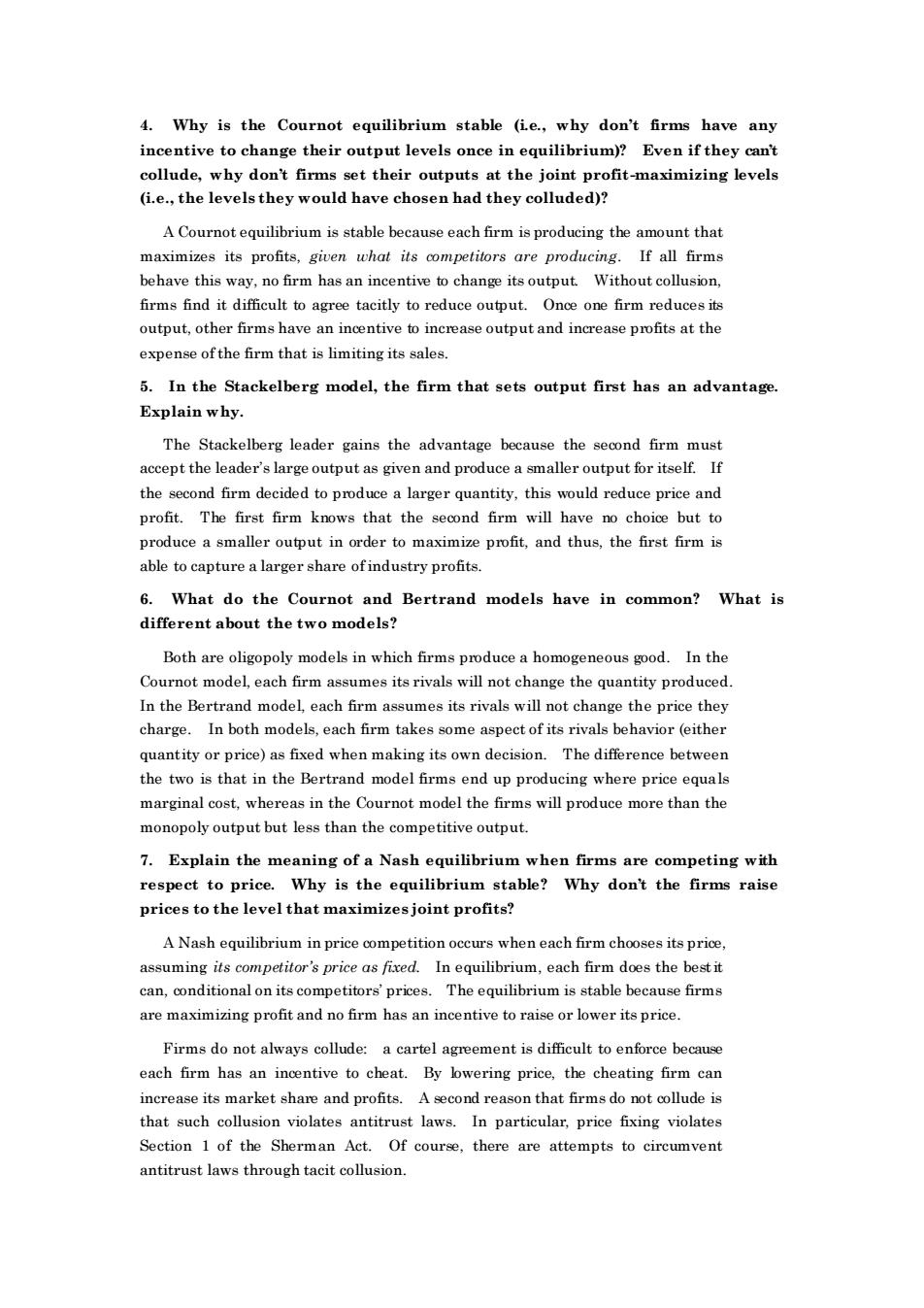
4.Why is the Cournot equilibrium stable (ie.,why don't firms have any incentive to change their output levels once in equilibrium)?Even if they can't collude why don't firms set their outputs at the joint profit-maximizing levels (i.e.,the levels they would have chosen had they colluded)? A Cournot equilibrium is stable because each firm is producing the amount that maximizes its profits,given what its competitors are producing.If all firms behave this way,no firm has an incentive to change its output Without collusion. firms find it difficult to agree tacitly to reduce ouput.Once one firm reduces its output,other firms hay in entive t expense of the firm that is limiting its sales 5.In the Stackelberg model,the firm that sets output first has an advantage Explain why. The Stackelberg leader gains the advantage because the second firm must accept the leader's large output as given and produce a smaller output for itself.If larger quantity,this would reduce price and profit.The first firm knowe that the snd frm will have no produce a smaller output in order to maximize profit,and thus,the first firm is able to capture a larger share ofindustry profits. 6.What do the Cournot and Bertrand models have in common?What is different about the two models? Both are oligopoly models in which firms produce a homogeneous good.In the Cournot model,each firm assumes its rivals will not change the quantit yproduced and model, each not change the price the charge In both models.each firm takes some aspect of its rivals behavior(either quantity or price)as fixed when making its own decision.The difference between the two is that in the Bertrand model firms end up producing where price equals marginal cost,whereas in the Cournot model the firms will produce more than the monopoly output but less than the competitive outpu 7.Explain the meaning of a Nash equilibrium when firm competing with respect to price. Why is the equilibrium stable? Why don't the firms rais prices to the level that maximizes joint profits? A Nash equilibrium in price competition occurs when each firm chooses its price assuming its competitor's price as fixed.In equilibrium.each firm does the best it can.conditional on its competitors'prices.The equilibrium is stable because firms are maximizing profit and no firm has an incentive to raise or lower its price each firm has an incentive to cheat.By bwering price,the cheating firm can increase its market share and profits.A second reason that firms do not collude is that such collusion violates antitrust laws.In particular,price fixing violates Section 1 of the Sherman Act.Of course.there are attempts to circumvent antitrust laws through tacit colusion
4. Why is the Cournot equilibrium stable (i.e., why don’t firms have any incentive to change their output levels once in equilibrium)? Even if they can’t collude, why don’t firms set their outputs at the joint profit -maximizing levels (i.e., the levels they would have chosen had they colluded)? A Cournot equilibrium is stable because each firm is producing the amount that maximizes its profits, given what its competitors are producing. If all firms behave this way, no firm has an incentive to change its output. Without collusion, firms find it difficult to agree tacitly to reduce output. Once one firm reduces its output, other firms have an incentive to increase output and increase profits at the expense of the firm that is limiting its sales. 5. In the Stackelberg model, the firm that sets output first has an advantage. Explain why. The Stackelberg leader gains the advantage because the second firm must accept the leader’s large output as given and produce a smaller output for itself. If the second firm decided to produce a larger quantity, this would reduce price and profit. The first firm knows that the second firm will have no choice but to produce a smaller output in order to maximize profit, and thus, the first firm is able to capture a larger share of industry profits. 6. What do the Cournot and Bertrand models have in common? What is different about the two models? Both are oligopoly models in which firms produce a homogeneous good. In the Cournot model, each firm assumes its rivals will not change the quantity produced. In the Bertrand model, each firm assumes its rivals will not change the price they charge. In both models, each firm takes some aspect of its rivals behavior (either quantity or price) as fixed when making its own decision. The difference between the two is that in the Bertrand model firms end up producing where price equals marginal cost, whereas in the Cournot model the firms will produce more than the monopoly output but less than the competitive output. 7. Explain the meaning of a Nash equilibrium when firms are competing with respect to price. Why is the equilibrium stable? Why don’t the firms raise prices to the level that maximizes joint profits? A Nash equilibrium in price competition occurs when each firm chooses its price, assuming its competitor’s price as fixed. In equilibrium, each firm does the best it can, conditional on its competitors’ prices. The equilibrium is stable because firms are maximizing profit and no firm has an incentive to raise or lower its price. Firms do not always collude: a cartel agreement is difficult to enforce because each firm has an incentive to cheat. By lowering price, the cheating firm can increase its market share and profits. A second reason that firms do not collude is that such collusion violates antitrust laws. In particular, price fixing violates Section 1 of the Sherman Act. Of course, there are attempts to circumvent antitrust laws through tacit collusion
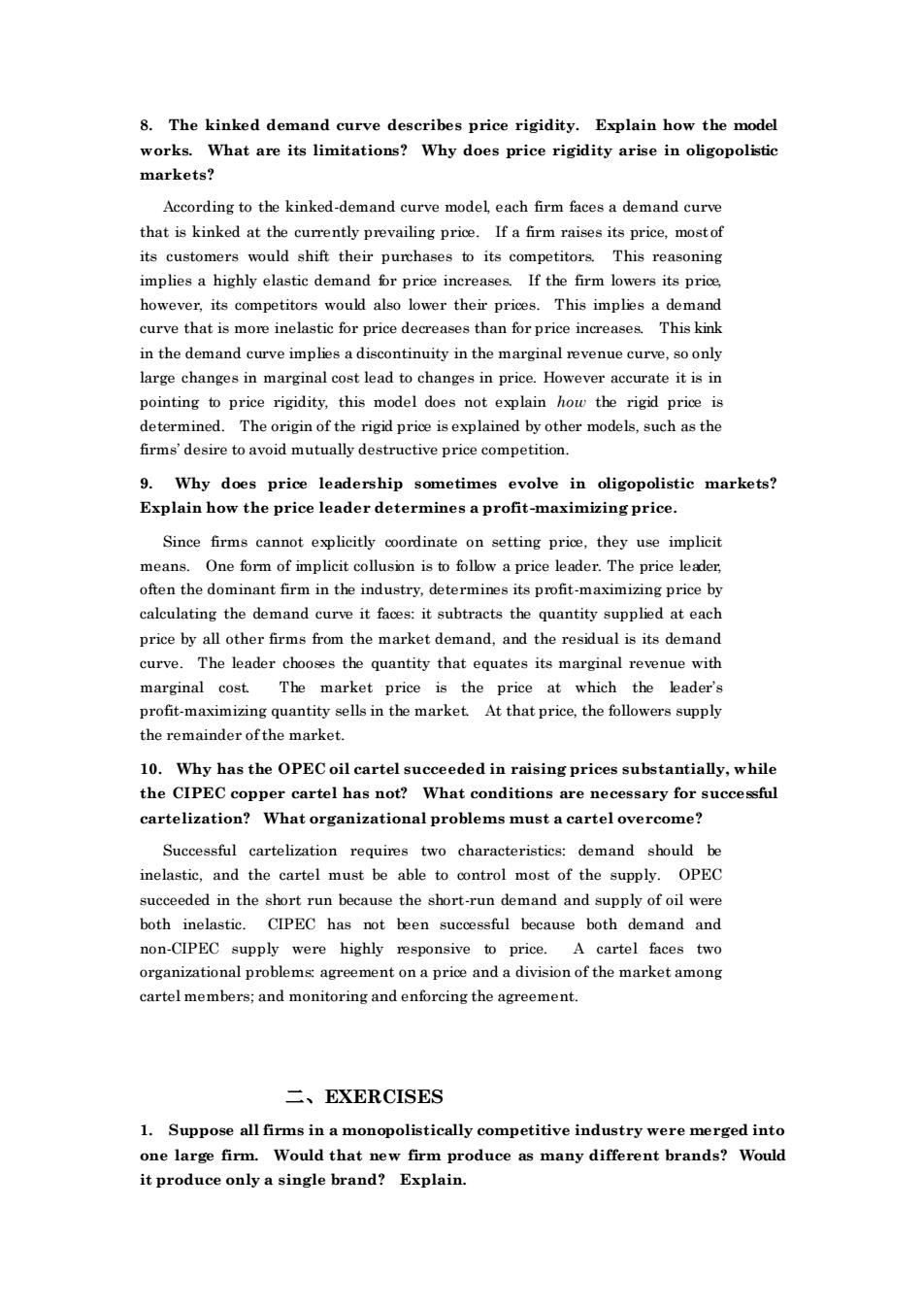
8.The kinked demand curve describes price rigidity.Explain how the model works.What are its limitations?Why does price rigidity arise in oligopolistic markets? According to the kinked-demand curve model each firm faces a demand curve that is kinked at the currently prevailing price.If a firm raises its price,mostof its customers would shift their purchases to its competitors.This reasoning implies a highly elastic demand for price increases.If the firm lowers its price er its etitor ould also wer thei prices.This This kink in the demand curve implies a discontinuity in the marginal revenue curve,so only large changes in marginal cost lead to changes in price.However accurate it is in pointing to price rigidity.this model does not explain how the rigid price is determined.The ofthe by other firmsdesire to avoid mutually de ructive price competition Why does price leadership sometimes evolve in oligopolistic markets? Explain how the price leader determines a profit-maximizing price. Since firms cannot explicitly coordinate on setting price,they use implicit means.One form of implicit collusion is to follw a price leader.The price leader often the dominant firm in the industry,determines its profit-maximizing price by calculating the demand curve itfaces:it subtracts the quantity supped at each price bya other firms from the market demand,and the residu al is its deman curve.The leader chooses the quantity that equates its marginal revenue with marginal cost The market price is the price at which the leader's profit-maximizing quantity sells in the market.At that price,the followers supply the remainder ofthe market. 10.Why has the OPEC oil cartel succeeded in raising prices substantially,while the CIPEC e pp cartel has not?What conditions are ne essary fo cartelization?What organizational problems must a cartel overcome? Successful cartelization requires two characteristics: demand should be inelastic.and the cartel must be able to control most of the supply.OPEC succeeded in the short run because the short-run demand and supply of oil were both inelastic.CIPEC has not been successful because both demand and non-CIPEC upp were highly price faces organizational proble ms agreement on a price and a division of the market among cartel members;and monitoring and enforcing the agreement. 二、EXERCISES 1.Suppose all firms in a monopolistically competitive industry were merged into one large firm.Would that new firm produce as many different brands?Would it produce only a single brand?Explain
8. The kinked demand curve describes price rigidity. Explain how the model works. What are its limitations? Why does price rigidity arise in oligopolistic markets? According to the kinked-demand curve model, each firm faces a demand curve that is kinked at the currently prevailing price. If a firm raises its price, most of its customers would shift their purchases to its competitors. This reasoning implies a highly elastic demand for price increases. If the firm lowers its price, however, its competitors would also lower their prices. This implies a demand curve that is more inelastic for price decreases than for price increases. This kink in the demand curve implies a discontinuity in the marginal revenue curve, so only large changes in marginal cost lead to changes in price. However accurate it is in pointing to price rigidity, this model does not explain how the rigid price is determined. The origin of the rigid price is explained by other models, such as the firms’ desire to avoid mutually destructive price competition. 9. Why does price leadership sometimes evolve in oligopolistic markets? Explain how the price leader determines a profit -maximizing price. Since firms cannot explicitly coordinate on setting price, they use implicit means. One form of implicit collusion is to follow a price leader. The price leader, often the dominant firm in the industry, determines its profit-maximizing price by calculating the demand curve it faces: it subtracts the quantity supplied at each price by all other firms from the market demand, and the residual is its demand curve. The leader chooses the quantity that equates its marginal revenue with marginal cost. The market price is the price at which the leader’s profit-maximizing quantity sells in the market. At that price, the followers supply the remainder of the market. 10. Why has the OPEC oil cartel succeeded in raising prices substantially, while the CIPEC copper cartel has not? What conditions are necessary for successful cartelization? What organizational problems must a cartel overcome? Successful cartelization requires two characteristics: demand should be inelastic, and the cartel must be able to control most of the supply. OPEC succeeded in the short run because the short-run demand and supply of oil were both inelastic. CIPEC has not been successful because both demand and non-CIPEC supply were highly responsive to price. A cartel faces two organizational problems: agreement on a price and a division of the market among cartel members; and monitoring and enforcing the agreement. 二、EXERCISES 1. Suppose all firms in a monopolistically competitive industry were merged into one large firm. Would that new firm produce as many different brands? Would it produce only a single brand? Explain
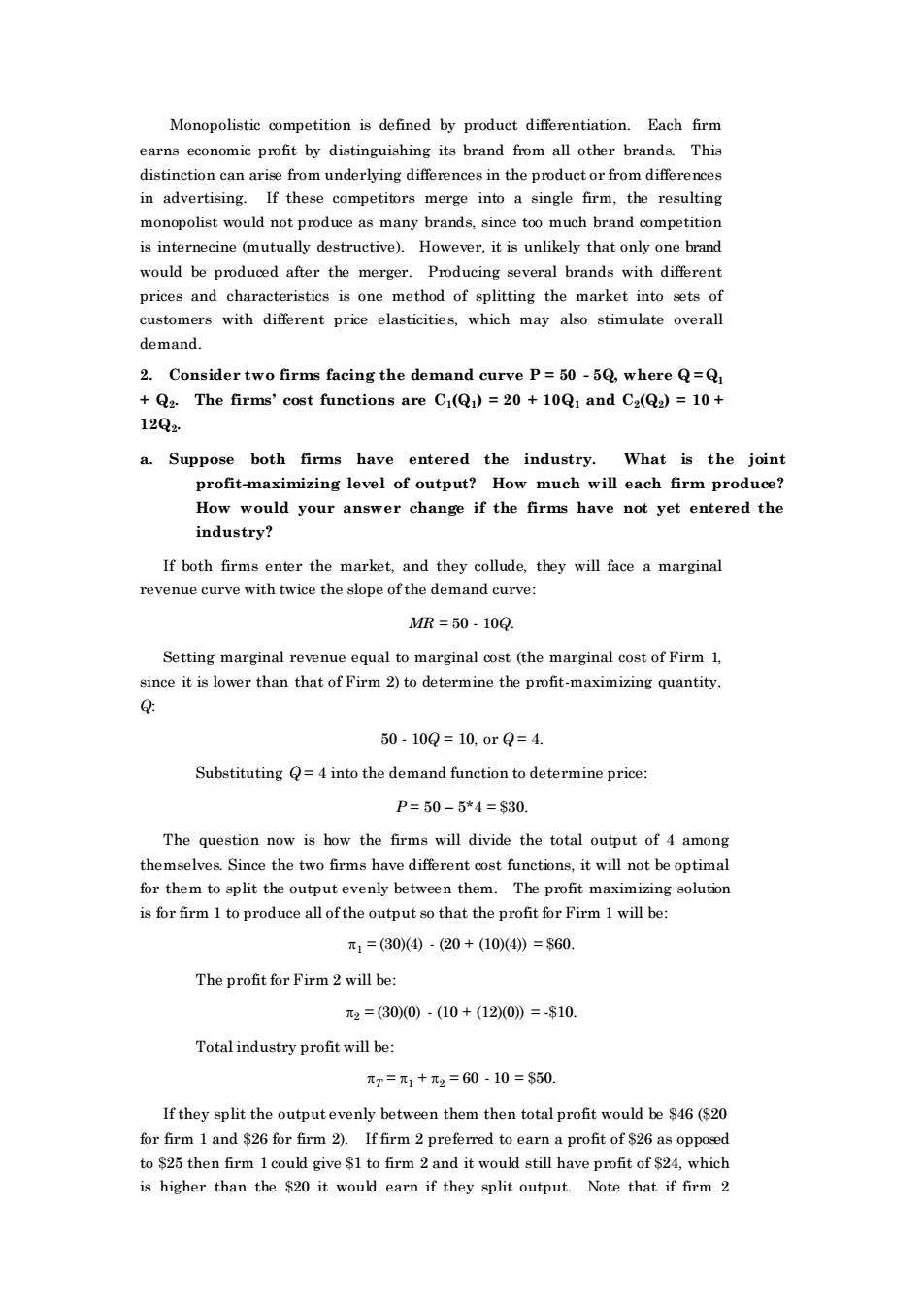
Monopolistic competition is defined by product differentiation.Each firm in advertising. If these competitors merge into a single firm,the resulting monopolist would not produce as many brands.since too much brand competition is internecine (mutually destructive).However,it is unlikely that only one brand would be produced afer the merger.Producing several brands withdifferen prices and c ha ristics is one method of spli tting the market into setso customers with different price elasticities,which may also stimulate overal demand. 2.Consider two firms facing the demand curve P=50-5Q where Q=Q +Q2.The firms'cost functions are C1(Q)=20+10Q1 and C2(Q2)=10+ 12Q4 a.Suppose both firms have entered the industr What is the ioint profit-maximizing level ofo output?How m uch will each firm produce? How would your answer change if the firms have not yet entered the industry? If both firms enter the market,and they collude,they will face a marginal revenue curve with twice the slope of the demand curve: MR=50.10Q. Setting marginal revenue equal to marginal oost(the marginal cost of Firm 1 since it is lower than that of Firm 2)to determine the profit-maximizing quantity. 50.10Q=10,orQ=4 Substituting=4into the demand function to determine price P=50-5*4=$30 The question now is bow the firms will divide the total output of 4 among themselves Since the two firms have different oost functions,it will not be optimal for them to split the output evenly between them.The profit maximizing solution is for firm 1 to produce all of the output so that the profit for Firm 1 will be: x1=(30)(④·.(20+(104)=$60. The profit for Firm 2 will be: 2=(300)-(10+(12)(0》=-$10. Total industry profit will be: r=元1+元2=60.10=S50. If they split the them then total profit would be6(20 for firm 1 and $26 for firm 2).If firm 2 prefe rred to earn a profit of $26 as oppo to $25 then firm 1 could give $1 to firm 2 and it would still have profit of $24,which is higher than the $20 it woul earn if they split output.Note that if firm 2
Monopolistic competition is defined by product differentiation. Each firm earns economic profit by distinguishing its brand from all other brands. This distinction can arise from underlying differences in the product or from differences in advertising. If these competitors merge into a single firm, the resulting monopolist would not produce as many brands, since too much brand competition is internecine (mutually destructive). However, it is unlikely that only one brand would be produced after the merger. Producing several brands with different prices and characteristics is one method of splitting the market into sets of customers with different price elasticities, which may also stimulate overall demand. 2. Consider two firms facing the demand curve P = 50 - 5Q, where Q = Q1 + Q2 . The firms’ cost functions are C1 (Q1 ) = 20 + 10Q1 and C2 (Q2 ) = 10 + 12Q2 . a. Suppose both firms have entered the industry. What is the joint profit-maximizing level of output? How much will each firm produce? How would your answer change if the firms have not yet entered the industry? If both firms enter the market, and they collude, they will face a marginal revenue curve with twice the slope of the demand curve: MR = 50 - 10Q. Setting marginal revenue equal to marginal cost (the marginal cost of Firm 1, since it is lower than that of Firm 2) to determine the profit-maximizing quantity, Q: 50 - 10Q = 10, or Q = 4. Substituting Q = 4 into the demand function to determine price: P = 50 – 5*4 = $30. The question now is how the firms will divide the total output of 4 among themselves. Since the two firms have different cost functions, it will not be optimal for them to split the output evenly between them. The profit maximizing solution is for firm 1 to produce all of the output so that the profit for Firm 1 will be: 1 = (30)(4) - (20 + (10)(4)) = $60. The profit for Firm 2 will be: 2 = (30)(0) - (10 + (12)(0)) = -$10. Total industry profit will be: T = 1 + 2 = 60 - 10 = $50. If they split the output evenly between them then total profit would be $46 ($20 for firm 1 and $26 for firm 2). If firm 2 preferred to earn a profit of $26 as opposed to $25 then firm 1 could give $1 to firm 2 and it would still have profit of $24, which is higher than the $20 it would earn if they split output. Note that if firm 2
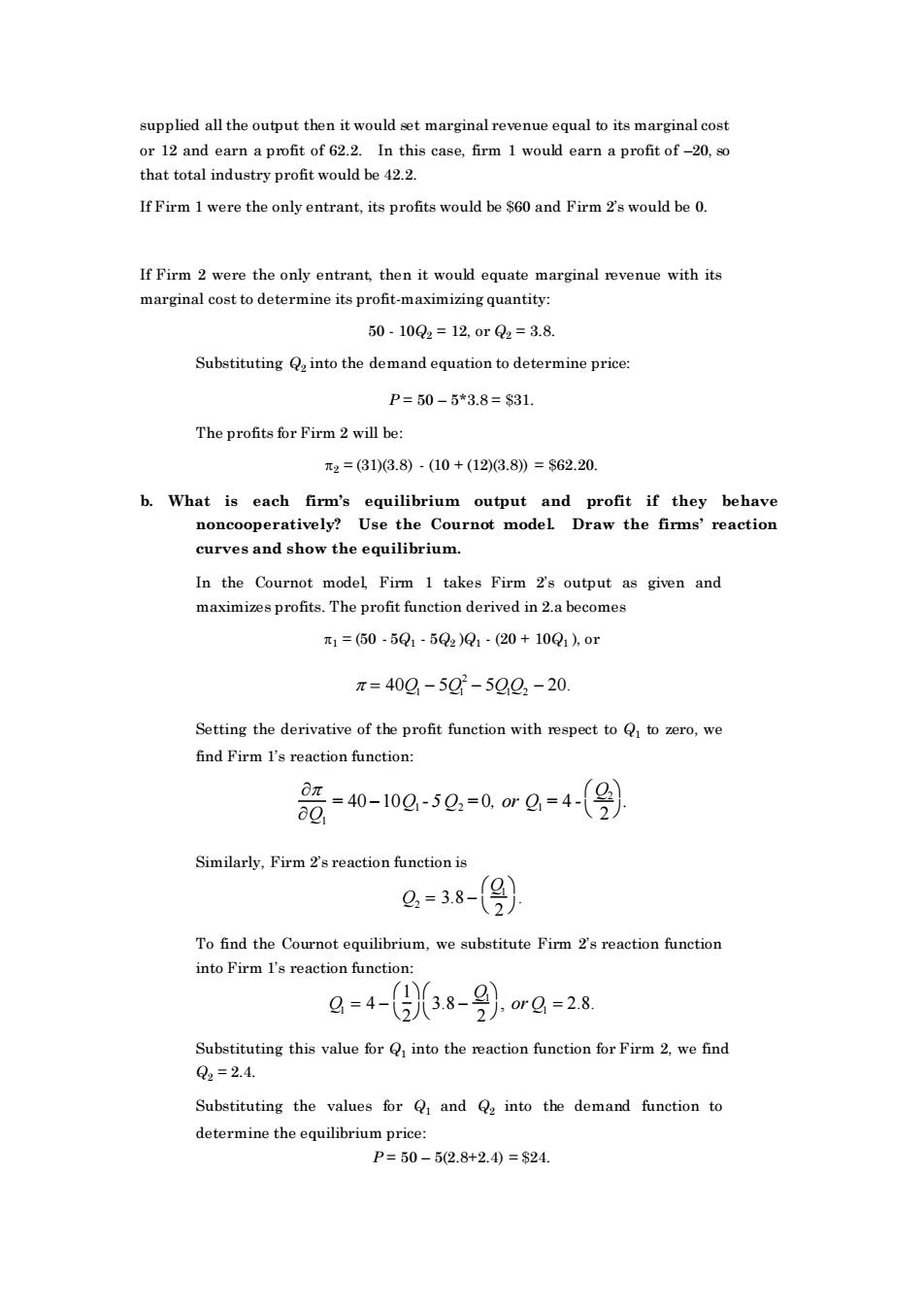
supplied all the output then it would set marginal revenue equal to its marginal cost or 12 and earn a profit of 62.2.In this case,firm 1 would earn a profit of-20,so that total industry profit would be 42.2. If Firm 1 were the only entrant.its profits would be60 and Firm2s would be 0. If Firm 2 were the only entrant,then it woul equate marginal revenue with its marginal cost to determine its profit-maximizing quantity: 50-10Q2=12.0rQ2=3.8 Substituting into the demand equation to determine price: P=50-5*3.8=$31. The profits for Firm 2 will be: 2=3103.8)·(10+(123.8》=s62.20. b.What is each firm's equilibrium output and profit if they behave noncooperatively?Use the Cournot model Draw the firms'reaction curves and show the equilibrium In the Cournot model Firm 1 takes Firm 2's output as given and maximizes profits.The profit function derived in 2.a becomes 元1=(60.5Q-5Q2)1(20+101o π=40g-5g-5Q22-20. Setting the derivative of the profit function with respect toto zero.we find Firm I's reaction function: ag =40-100-50,=0m2=4-(9》 Similarly,Firm 2s reaction functionis g=38-(》 To find the Cournot equilibrium.we substitute Firm 2's reaction function into Firm I's reaction function: g=4-⑤3.8-)rg=28 1 Substituting this value for into the reaction function for Firm 2,we fin Q2=2.4 Substituting the values for and into the demand function to determine the equilibrium price: P=50-52.8+2.4)=$24
supplied all the output then it would set marginal revenue equal to its marginal cost or 12 and earn a profit of 62.2. In this case, firm 1 would earn a profit of –20, so that total industry profit would be 42.2. If Firm 1 were the only entrant, its profits would be $60 and Firm 2’s would be 0. If Firm 2 were the only entrant, then it would equate marginal revenue with its marginal cost to determine its profit-maximizing quantity: 50 - 10Q2 = 12, or Q2 = 3.8. Substituting Q2 into the demand equation to determine price: P = 50 – 5*3.8 = $31. The profits for Firm 2 will be: 2 = (31)(3.8) - (10 + (12)(3.8)) = $62.20. b. What is each firm’s equilibrium output and profit if they behave noncooperatively? Use the Cournot model. Draw the firms’ reaction curves and show the equilibrium. In the Cournot model, Firm 1 takes Firm 2’s output as given and maximizes profits. The profit function derived in 2.a becomes 1 = (50 - 5Q1 - 5Q2 )Q1 - (20 + 10Q1 ), or = 40Q1 − 5Q1 2 − 5Q1Q2 − 20. Setting the derivative of the profit function with respect to Q1 to zero, we find Firm 1’s reaction function: Q1 = 40 −10Q1 - 5Q2 =0, or Q1 = 4 - Q2 2 . Similarly, Firm 2’s reaction function is Q2 = 3.8 − Q1 2 . To find the Cournot equilibrium, we substitute Firm 2’s reaction function into Firm 1’s reaction function: Q1 = 4 − 1 2 3.8 − Q1 2 , or Q1 = 2.8. Substituting this value for Q1 into the reaction function for Firm 2, we find Q2 = 2.4. Substituting the values for Q1 and Q2 into the demand function to determine the equilibrium price: P = 50 – 5(2.8+2.4) = $24